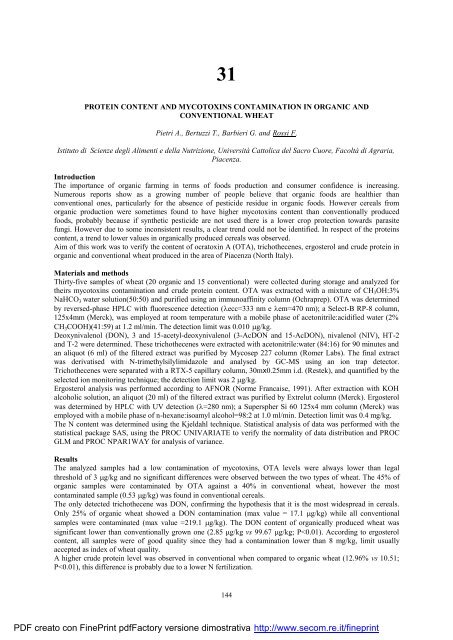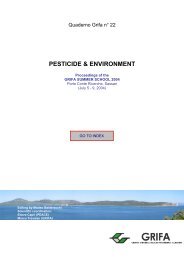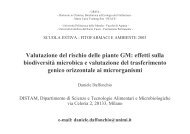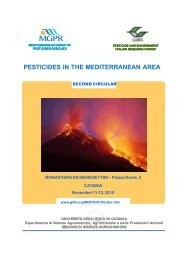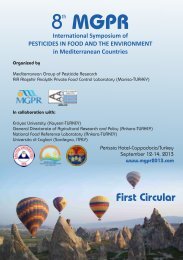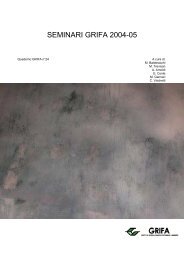International Congress BIOLOGICAL PRODUCTS - Gruppo di ...
International Congress BIOLOGICAL PRODUCTS - Gruppo di ...
International Congress BIOLOGICAL PRODUCTS - Gruppo di ...
You also want an ePaper? Increase the reach of your titles
YUMPU automatically turns print PDFs into web optimized ePapers that Google loves.
31<br />
PROTEIN CONTENT AND MYCOTOXINS CONTAMINATION IN ORGANIC AND<br />
CONVENTIONAL WHEAT<br />
Pietri A., Bertuzzi T., Barbieri G. and Rossi F.<br />
Istituto <strong>di</strong> Scienze degli Alimenti e della Nutrizione, Università Cattolica del Sacro Cuore, Facoltà <strong>di</strong> Agraria,<br />
Piacenza.<br />
Introduction<br />
The importance of organic farming in terms of foods production and consumer confidence is increasing.<br />
Numerous reports show as a growing number of people believe that organic foods are healthier than<br />
conventional ones, particularly for the absence of pesticide residue in organic foods. However cereals from<br />
organic production were sometimes found to have higher mycotoxins content than conventionally produced<br />
foods, probably because if synthetic pesticide are not used there is a lower crop protection towards parasite<br />
fungi. However due to some inconsistent results, a clear trend could not be identified. In respect of the proteins<br />
content, a trend to lower values in organically produced cereals was observed.<br />
Aim of this work was to verify the content of ocratoxin A (OTA), trichothecenes, ergosterol and crude protein in<br />
organic and conventional wheat produced in the area of Piacenza (North Italy).<br />
Materials and methods<br />
Thirty-five samples of wheat (20 organic and 15 conventional) were collected during storage and analyzed for<br />
theirs mycotoxins contamination and crude protein content. OTA was extracted with a mixture of CH3OH:3%<br />
NaHCO3 water solution(50:50) and purified using an immunoaffinity column (Ochraprep). OTA was determined<br />
by reversed-phase HPLC with fluorescence detection (λecc=333 nm e λem=470 nm); a Select-B RP-8 column,<br />
125x4mm (Merck), was employed at room temperature with a mobile phase of acetonitrile:aci<strong>di</strong>fied water (2%<br />
CH3COOH)(41:59) at 1.2 ml/min. The detection limit was 0.010 µg/kg.<br />
Deoxynivalenol (DON), 3 and 15-acetyl-deoxynivalenol (3-AcDON and 15-AcDON), nivalenol (NIV), HT-2<br />
and T-2 were determined. These trichothecenes were extracted with acetonitrile:water (84:16) for 90 minutes and<br />
an aliquot (6 ml) of the filtered extract was purified by Mycosep 227 column (Romer Labs). The final extract<br />
was derivatised with N-trimethylsilylimidazole and analysed by GC-MS using an ion trap detector.<br />
Trichothecenes were separated with a RTX-5 capillary column, 30mx0.25mm i.d. (Restek), and quantified by the<br />
selected ion monitoring technique; the detection limit was 2 µg/kg.<br />
Ergosterol analysis was performed accor<strong>di</strong>ng to AFNOR (Norme Francaise, 1991). After extraction with KOH<br />
alcoholic solution, an aliquot (20 ml) of the filtered extract was purified by Extrelut column (Merck). Ergosterol<br />
was determined by HPLC with UV detection (λ=280 nm); a Superspher Si 60 125x4 mm column (Merck) was<br />
employed with a mobile phase of n-hexane:isoamyl alcohol=98:2 at 1.0 ml/min. Detection limit was 0.4 mg/kg.<br />
The N content was determined using the Kjeldahl technique. Statistical analysis of data was performed with the<br />
statistical package SAS, using the PROC UNIVARIATE to verify the normality of data <strong>di</strong>stribution and PROC<br />
GLM and PROC NPAR1WAY for analysis of variance.<br />
Results<br />
The analyzed samples had a low contamination of mycotoxins, OTA levels were always lower than legal<br />
threshold of 3 µg/kg and no significant <strong>di</strong>fferences were observed between the two types of wheat. The 45% of<br />
organic samples were contaminated by OTA against a 40% in conventional wheat, however the most<br />
contaminated sample (0.53 µg/kg) was found in conventional cereals.<br />
The only detected trichothecene was DON, confirming the hypothesis that it is the most widespread in cereals.<br />
Only 25% of organic wheat showed a DON contamination (max value = 17.1 µg/kg) while all conventional<br />
samples were contaminated (max value =219.1 µg/kg). The DON content of organically produced wheat was<br />
significant lower than conventionally grown one (2.85 µg/kg vs 99.67 µg/kg; P


